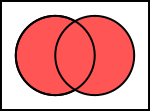
A | B | C | D | E | F | G | H | CH | I | J | K | L | M | N | O | P | Q | R | S | T | U | V | W | X | Y | Z | 0 | 1 | 2 | 3 | 4 | 5 | 6 | 7 | 8 | 9
| OR | |
|---|---|
 | |
| Definition | |
| Truth table | |
| Logic gate | |
| Normal forms | |
| Disjunctive | |
| Conjunctive | |
| Zhegalkin polynomial | |
| Post's lattices | |
| 0-preserving | yes |
| 1-preserving | yes |
| Monotone | yes |
| Affine | no |
| Logical connectives | ||||||||||||||||||||||
|---|---|---|---|---|---|---|---|---|---|---|---|---|---|---|---|---|---|---|---|---|---|---|
|
||||||||||||||||||||||
| Related concepts | ||||||||||||||||||||||
| Applications | ||||||||||||||||||||||
|
| ||||||||||||||||||||||

In logic, disjunction, also known as logical disjunction or logical or or logical addition or inclusive disjunction, is a logical connective typically notated as and read aloud as "or". For instance, the English language sentence "it is sunny or it is warm" can be represented in logic using the disjunctive formula , assuming that abbreviates "it is sunny" and abbreviates "it is warm".
In classical logic, disjunction is given a truth functional semantics according to which a formula is true unless both and are false. Because this semantics allows a disjunctive formula to be true when both of its disjuncts are true, it is an inclusive interpretation of disjunction, in contrast with exclusive disjunction. Classical proof theoretical treatments are often given in terms of rules such as disjunction introduction and disjunction elimination. Disjunction has also been given numerous non-classical treatments, motivated by problems including Aristotle's sea battle argument, Heisenberg's uncertainty principle, as well as the numerous mismatches between classical disjunction and its nearest equivalents in natural languages.[1][2]
An operand of a disjunction is a disjunct.[3]
Inclusive and exclusive disjunction
Because the logical "or" means a disjunction formula is true when either one or both of its parts are true, it is referred to as an inclusive disjunction. This is in contrast with an exclusive disjunction, which is true when one or the other of the arguments are true, but not both (referred to as "exclusive or", or "XOR").
When it is necessary to clarify whether inclusive or exclusive "or" is intended, English speakers sometimes uses the phrase "and/or". In terms of logic, this phrase is identical to "or", but makes the inclusion of both being true explicit.
Notation
In logic and related fields, disjunction is customarily notated with an infix operator (Unicode U+2228 ∨ LOGICAL OR).[1] Alternative notations include , used mainly in electronics, as well as and in many programming languages. The English word "or" is sometimes used as well, often in capital letters. In Jan Łukasiewicz's prefix notation for logic, the operator is , short for Polish alternatywa (English: alternative).[4]
Classical disjunction
Semantics
In the semantics of logic, classical disjunction is a truth functional operation which returns the truth value "true" unless both of its arguments are "false". Its semantic entry is standardly given as follows:[5]
- if or or both
This semantics corresponds to the following truth table:[1]
| F | F | F |
| F | T | T |
| T | F | T |
| T | T | T |
Defined by other operators
In classical logic systems where logical disjunction is not a primitive, it can be defined in terms of the primitive "and" () and "not" (
Antropológia
Aplikované vedy
Bibliometria
Dejiny vedy
Encyklopédie
Filozofia vedy
Forenzné vedy
Humanitné vedy
Knižničná veda
Kryogenika
Kryptológia
Kulturológia
Literárna veda
Medzidisciplinárne oblasti
Metódy kvantitatívnej analýzy
Metavedy
Metodika
Text je dostupný za podmienok Creative
Commons Attribution/Share-Alike License 3.0 Unported; prípadne za ďalších
podmienok.
Podrobnejšie informácie nájdete na stránke Podmienky
použitia.
www.astronomia.sk | www.biologia.sk | www.botanika.sk | www.dejiny.sk | www.economy.sk | www.elektrotechnika.sk | www.estetika.sk | www.farmakologia.sk | www.filozofia.sk | Fyzika | www.futurologia.sk | www.genetika.sk | www.chemia.sk | www.lingvistika.sk | www.politologia.sk | www.psychologia.sk | www.sexuologia.sk | www.sociologia.sk | www.veda.sk I www.zoologia.sk






















































